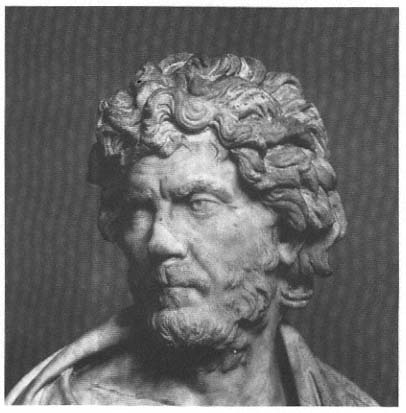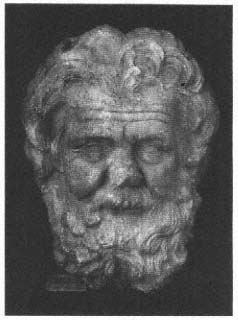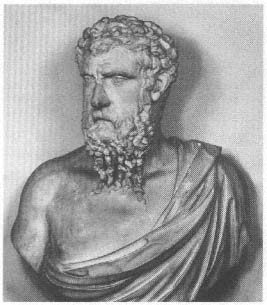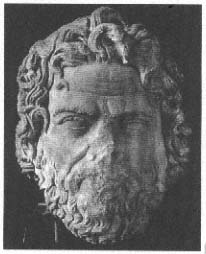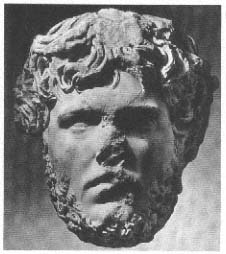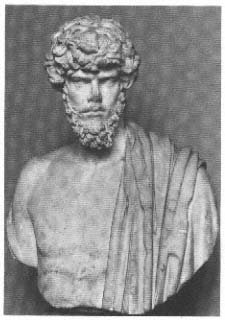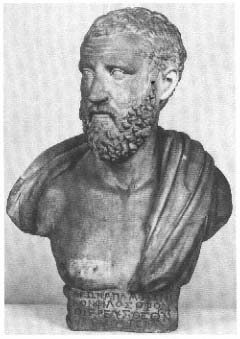Apuleius and the Case of the Uncombed Hair
When the writer Apuleius, who came from Madaura in North Africa, married a wealthy widow about A.D. 160, her family, fearing the loss of their inheritance, ensnared him in a lawsuit on charges of magic that
could have had serious consequences.[46] He was also accused, among other things, of passing himself off as a philosopher under false pretences. As evidence they cited his handsome and carefully tended appearance, describing him, ironically, as philosophus formosus . Instead of philosophy, they claimed, he was really practicing the magical arts, that is, he had bewitched the widow. Thus if a man wanted to be acknowledged publicly as a philosopher, at least according to Apuleius' accusers and the people of Sabratha, where the trial took place, the one thing he could not appear was handsome. Apuleius at first responded with a learned defense, in which he cited examples of handsome Greek philosophers, including Pythagoras, but then continued:
And yet this sort of defense does not suit a man of my humble appearance. The constant strain of study has drained all the charms of my body, bent my posture, dried out my vital juices, turned my face pale, and crippled my powers. And as for my hair, which these brazen liars claim to be worthy of a seducer: just look at it, and see how elegant and seductive it is! Twisted and tangled, stiff like straw, stringy, clotted in little lumps, it has been untended for so long that it could never be disentangled, let alone combed or parted.
(Apol. 4.1)
Undoubtedly this is how Apuleius appeared in court, otherwise his eloquent defense would have seemed ludicrous. The learned proconsul Claudius Maximus was won over and declared him not guilty. Yet his accusers were probably not the "shameless liars" he claimed them to be. For as a celebrated rhetorician, priest in the imperial cult, and suitor for the hand of the widow, he cannot have appeared in public with unwashed hair all the time. The citizens of Carthage celebrated him, in the inscription beneath his honorific statue, as philosophus platonicus,[47] and such a comparison had always conjured up a well-tended appearance (cf. p. 240). We can conclude only that Apuleius deliberately played a variety of roles, depending on the exigencies of a particular situation. And this is probably true of other famous intellectuals of the second century as well, who moved, as J. Hahn put it, "in that shadowy zone between philosophy and the Sophists."
The case of Apuleius shows that there was a certain pressure on the professional intellectual who was also a public figure to define his own image, that is, to declare himself as either rhetorician/Sophist or philosopher. When a well-known figure officially made the transition from one profession to the other, this might even be staged as a kind of public ritual. For example, when one Aristokles, a Pergamene aristocrat, gave up his affiliation with the Peripatos and became a rhetorician and pupil of Herodes Atticus, he also renounced his earlier disregard for his own appearance, with uncombed hair and filthy clothes (these had evidently become generally recognized symbols of the philosophical way of life, irrespective of which school one belonged to), and took on not only a soigné image but also the appropriate friends. From now on he would cultivate a life of luxury and pleasure, replete with music, theatre, and banquets (Philostr. VS 2.3.567). And when Peregrinus Proteus did the reverse, taking the "vows" of a strict philosophical life and, like a medieval saint, giving away his inheritance to the city of Parion, this was done in the form of a public spectacle, at which the people cheered his conversion, shouting: "Yea, thou art truly a philosopher, truly a patriot, a true follower of Diogenes and Krates" (Lucian Peregr. 15).[48]
These efforts at self-definition, and others like them, were "classical revivals," as it were, replaying the old debate between Isocrates and Plato on what should take precedence in the education of the young. But the insistence upon a fundamental distinction between the two ways of life cannot have been mirrored in the actual practices of daily life, which was marked rather by continual compromise. Indicative of this is the way that Philostratus speaks of "the philosophical oratory" of the ancient Sophists (VS 1.480).
It is against this background, I believe, that a whole series of unusual portraits becomes intelligible. A well-known bust in Vienna has long been taken to be that of a barbarian, on account of the unkempt, almost ravaged appearance (fig. 127).[49] In fact, the head could be an illustration of Apuleius' masquerade in court. The long, coarse, and irregularly trimmed hair is presented as a hopelessly tangled mass of thickly matted strands against which no comb would stand a chance. The short beard grows irregularly and is as wild and unkempt as the
Fig. 127
Bust of a man in the guise of a serious philosopher. Ca. A.D. 160.
Vienna, Kunsthistorisches Museum.
hair. In addition, ugly traits like the scar and a wandering eye are emphasized. The lower part of the bust, with its Greek himation, which is not modern restoration, confirms that this individual is indeed a man who wishes to proclaim his adherence to a rigorous philosophical way of life. An earlier, Hadrianic head of an old man is no less unkempt and likewise lays claim to the life-style of a Cynic philosopher, since his wild hair is a virtual quotation from portraits like that of Antisthenes (fig. 128).[50]
Fig. 128
Portrait of an Athenian characterized as
a "new Antisthenes." Antonine
period. Athens, National Museum.
Both these heads come from Athens, the mecca of the cult of learning in the Imperial period, as also do the portraits of the kosmetai, which remain the most impressive examples of the revival of the "ancient Greek" image. But even in Rome itself there were men who valued an image of strict philosophical observance. Thus, for example, a portrait in the Capitoline Museum presents a haggard old man with ill-tempered expression, his hair matted in little clumps and a long "Pythagorean" beard that would defy any comb (fig. 129).[51]
Such extreme instances are, to be sure, not very numerous. Interestingly, the types most commonly met are compromises, uniting varied iconographical elements into an eclectic combination. Evidently the majority of men who prized the philosophical image also wanted to appear at the same time cosmopolitan and thus combined features
Fig. 129
Bust of a philosopher, or of a Roman
citizen leading a strict philosophical life. Rome,
Capitoline Museum.
of philosophical seriousness with those of a bourgeois urbanity. In another portrait from Athens, for example—this one found on the Acropolis—the stylization of the hair across the forehead is clearly an allusion to Antisthenes, the original Cynic, while the beard and facial expression, in contrast, look carefully tended, and even the hair relaxes into gentle locks as it moves toward the sides (fig. 130).[52] The figure from the Dion group discussed earlier, with the long beard and the Epicurean body, has a hairstyle that is rather in the tradition of Antisthenes and, strictly speaking, does not suit at all the proper bourgeois pose of the statue of Epicurus (fig. 125a).
Once we have become attuned to this phenomenon, it becomes clear that there exists a whole series of heads with noticeably unkempt hair, for which we must consider the possibility that the subject in-
Fig. 130
"New Antisthenes" from the Acropolis.
Antonine period. Athens, Acropolis Museum.
Fig. 131
Portrait of an anonymous contemporary of
Lucius Verus, ca. A.D. 160. Rome, Terme Museum.
tended in this way to call attention to his ascetic way of life. The most striking examples come once again from Athens, but quite a few have been found in the West as well.[53] The story of Apuleius' day in court confirms that this trait was indeed generally understood as a symbol of asceticism. An even earlier example of this phenomenon may be seen in the splendid Hadrianic shoulder bust from Rome, now in Copenhagen (fig. 132).[54] The carving of the locks of hair is a tour de force, but the mass of thick clumps could be meant to look matted and uncombed, especially since the young man has had himself depicted with no undergarment and with a skeptical, almost glowering look. Likewise, the subject of a well-known head in the Terme Museum in Rome (fig. 131), once erroneously taken to be a portrait of Lucius
Fig. 132
Bust of a dandy with philosophical
pretensions. Hadrianic period. Copenhagen,
Ny Carlsberg Glyptotek.
Verus, might have used the same means to project a philosophical image.[55] For the modern viewer it is of course not always easy (particularly with the state of preservation of some heads) to distinguish between an artfully arranged wig and naturally wild hair.
Yet the case of Apuleius makes it clear that defining oneself as an ascetic no longer entailed an identification with a particular philosophical school. Apuleius, after all, who boasted in court of his Cynic's unkempt hair, was regarded as a Platonist, while Theon of Smyrna, a contemporary of Hadrian, who is likewise designated as platonikos philosophos on a bust from Smyrna now in the Capitoline Museum (fig. 133), has a well-tended appearance with the close-cropped hair that traditionally marked the Stoic (cf p. 111).[56] He, too, apparently
Fig. 133
Bust of the Platonic philosopher Theon. Hadrianic
period. Rome, Capitoline Museum.
wished to be considered a "moderate" ascetic. This would also explain why the contemporary kosmetes in Athens who is otherwise so reminiscent of Plato wears his hair cut very short (fig. 116).
We do not know where most of these busts were originally displayed and whether the majority of them represent a professional philosopher or a "layman." But the large number of busts bearing a "philosophical" look in itself suggests that most are laymen. The original viewer probably could not distinguish either, in the absence of an inscription or knowledge of the individual. But the visual evidence tends to confirm the argument that in this period philosophy was less concerned with the clear definition of specific schools of thought than with promoting a spiritually oriented attitude and way of life.[57] These
portraits, then, stand in sharp contrast to the original portraits of the great philosophers of the third century B.C. , which had drawn clear distinctions among the various life-styles and philosophical orientations. The contemporary philosopher Demonax, who was so revered by Lucian (or perhaps invented by him), explicitly admits to a kind of eclecticism in the matter of academic teachings and sees the philosophical way of life as the true essence of all philosophical thought (Lucian Demon .). Asceticism, the renunciation of luxury, and continual mental exercise had become the basic components of philosophy in all the different schools. Neglect of one's outward appearance was the visible symbol of this way of life and proclaimed a commitment to a form of self-fulfillment based on strict moral principles. Thus when an otherwise elegant gentleman like the Platonist Theon had his hair cut short, this was probably a none-too-subtle indication that he wanted to be taken more seriously.
Those individuals who had themselves portrayed with unkempt hair and glowering mien may on occasion actually have appeared in public this way, like Apuleius in court. This would in turn imply that projecting such an image did not necessarily do any harm to a man's reputation among his social equals and the community at large. Self-control was now the mark of a man of distinction and justified his social status. A regimen of daily mental exercise was indispensable. The emperor Marcus Aurelius is one among many who aimed to put into practice a philosophical way of life. His Meditations were meant to instill self-control and to be a reminder of the philosophical principles that should govern our lives. These exercises were not practiced alone, but as part of an interchange with like-minded individuals under the guidance of an instructor.
They were in turn complemented by the practice of a physical asceticism, as in the regimen of the monastery, though we learn little of this in our sources. But we may presume that Marcus Aurelius was just one of many who slept on the floor as a token of his ascetic nature and to set an example for others (Hist. Aug., M. Ant. 2.6–7). Restraint in both eating and sexual activity reflect a concern for body as well as spirit. The same attention was devoted to both maintaining a certain diet and controlling the digestion.
